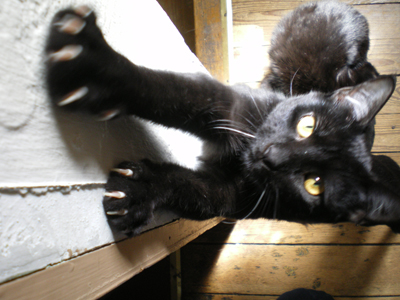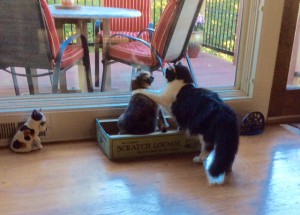 ForbesAdvisor.com reports that of 86.9 million U.S. cat-owning households, more than 46.5 million own more than one cat. These multiple-cat households must have learned that to achieve feline harmony in their homes, they must make sure that there are enough resources and space for their cats. If your cats know they have options on where they can eat, sleep, play, and use the litter box, all the better. If the cats have only one option, expect territorial disputes and added stress among them.
ForbesAdvisor.com reports that of 86.9 million U.S. cat-owning households, more than 46.5 million own more than one cat. These multiple-cat households must have learned that to achieve feline harmony in their homes, they must make sure that there are enough resources and space for their cats. If your cats know they have options on where they can eat, sleep, play, and use the litter box, all the better. If the cats have only one option, expect territorial disputes and added stress among them.
Here are a few pointers on how to create and keep harmony in your multiple-cat household:
- The first introduction of cats to each other should be gradual and free from stress. If possible, keep the new cat in a separate living area of your home, with their food, litter box, and toys. Your “incumbent cat(s)” will know about the new cat, but not have the stress of direct contact. After a few days, gradually allow your “incumbent” cat(s) to approach the new cat, keeping their contacts short and sweet. After a few more days, you will have achieved a successful introduction.
- Our strongest recommendation: invest in vertical play spaces. Cat trees, shelves and window perches are ideal ways to give your cats privacy in an off-the-ground location. Cats like height, so vertical options are a purr-fect solution.
- Your cats need outlets for exercising and scratching. Leave plenty of scratching devices around your home. Whether they are horizontal, vertical or slanted pads, they will protect your furniture as well as your sanity!
- Give each of your cats a separate food bowl! If you have common water bowls, have several in different areas. A water fountain designed for multiple cats is a great way of managing this. Just make sure to keep the fountain and the water it holds both clean and fresh.
- Keep as many litter boxes in your home as the number of cats then add one! One of the worst problems can arise when cats have to use the same box. Territorial issues may arise, causing them to “spray” the litter box, which signals to the other cats to stay away. No one needs to have cats using undesignated areas of the house. Once that “out-of-box” behavior starts, it’s hard to stop.
- Finally, watch your cats’ interactions. Observe body language and catch an early warning signal so that you can diffuse any tension and avoid an out-and-out battle. One great technique for diffusing attention is to introduce a stimulating wand toy to immediately redirect their attention away from one another and onto the moving object at the end of the wand.
Congratulations on your growing feline family! May you and your cats enjoy many harmonious and joyous moments together throughout their nine lives!
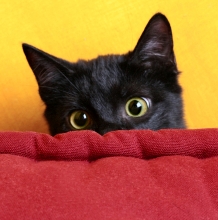
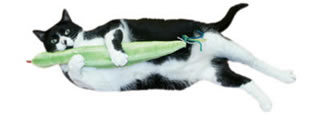
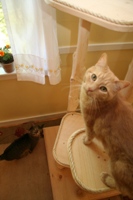
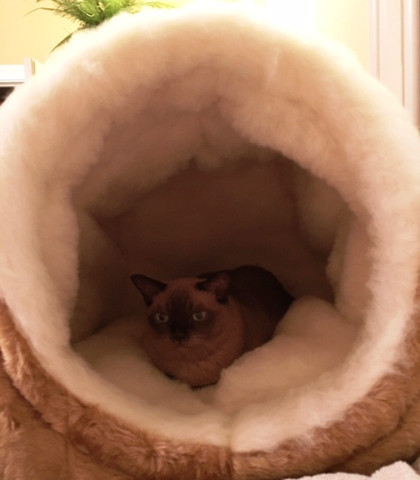
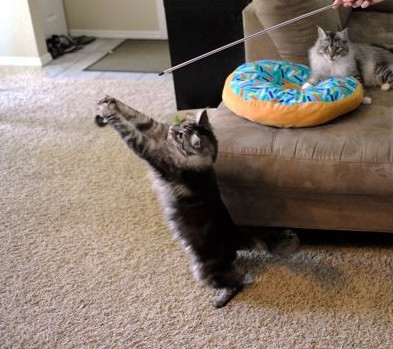
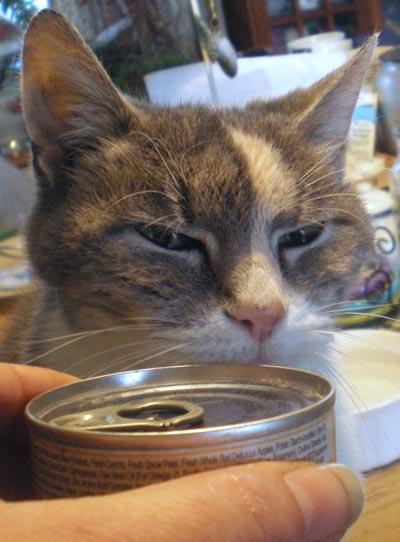 A healthy cat will eat what you give her, a kitty who is a little under the weather may need some persuasion; we won’t be talking about those manipulative and overly dramatic “finicky” kitties here. We’re considering cats who are recovering from illness or injury or who are elderly, and for whom even eating is a little bit of a burden. She may seem hungry, even show up for mealtime, but take a sniff or even attempt to eat and walk away. Often illness, surgery, trauma or age reduce a cat’s appetite through weakness, stomach upset, loss of smell or loss of taste, and a cat in a slightly weakened condition may need some inspiration for the taste buds. First, wake her up at least 15 minutes before you want to feed her—a sleepy kitty in a weakened condition isn’t ready to eat as soon as she wakes up, so pet her and give her attention for a while until she seems entirely alert. Always use fresh food, usually canned, so its smell is the strongest, and you don’t need to resort to fish-based foods, often liver-based food is more appealing. Then tease her with the food—play “kitty airplane” the same way you would with a recalcitrant child, show her the can and her dish, open the can and let kitty sniff the food then put it aside, making a big show of getting her dish ready, putting the food in the dish, allowing her to smell it all the while, then finally present it. This little play helps to get her digestive system started and her body gives her the signal to eat, plus, she’s wondering what they heck you’re up to, and curiosity is a big stimulant for a cat. If she’s still reluctant, pick up a little in a spoon and offer it for her to lick off; a little at a time is sometimes just enough. Don’t leave her food out, but put it back in the can and keep it, offering it again a little later. It may mean wasting a few cans, but open a new can with every session. She’ll appreciate your efforts.
A healthy cat will eat what you give her, a kitty who is a little under the weather may need some persuasion; we won’t be talking about those manipulative and overly dramatic “finicky” kitties here. We’re considering cats who are recovering from illness or injury or who are elderly, and for whom even eating is a little bit of a burden. She may seem hungry, even show up for mealtime, but take a sniff or even attempt to eat and walk away. Often illness, surgery, trauma or age reduce a cat’s appetite through weakness, stomach upset, loss of smell or loss of taste, and a cat in a slightly weakened condition may need some inspiration for the taste buds. First, wake her up at least 15 minutes before you want to feed her—a sleepy kitty in a weakened condition isn’t ready to eat as soon as she wakes up, so pet her and give her attention for a while until she seems entirely alert. Always use fresh food, usually canned, so its smell is the strongest, and you don’t need to resort to fish-based foods, often liver-based food is more appealing. Then tease her with the food—play “kitty airplane” the same way you would with a recalcitrant child, show her the can and her dish, open the can and let kitty sniff the food then put it aside, making a big show of getting her dish ready, putting the food in the dish, allowing her to smell it all the while, then finally present it. This little play helps to get her digestive system started and her body gives her the signal to eat, plus, she’s wondering what they heck you’re up to, and curiosity is a big stimulant for a cat. If she’s still reluctant, pick up a little in a spoon and offer it for her to lick off; a little at a time is sometimes just enough. Don’t leave her food out, but put it back in the can and keep it, offering it again a little later. It may mean wasting a few cans, but open a new can with every session. She’ll appreciate your efforts.